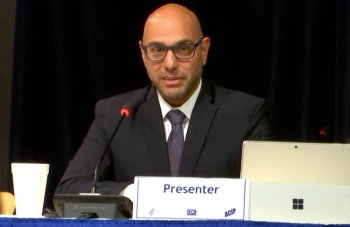
High-Dose Influenza Vaccine Study Results and Conclusions
Jason Lee, M.S., Ph.D.(c), discusses results and takeaways from the study of a high-dose influenza vaccine in older adults.
Episodes in this series

Jason Lee, M.S., Ph.D.(c): We’ll now move on and look at the different results of the study split by individual clinical outcomes, but first I’ll take a minute to explain the study methodology and what you’re seeing on these slides. After we conducted our literature search, we conducted meta-analyses that aimed to combine the results of these studies into pooled estimates by individual study outcomes. To do this, we pulled out the odds ratios in our identified studies for each individual clinical outcome and each individual influenza season. For example, if a study was conducted over two years and looked at the efficacy of the high-dose vaccine vs influenza-like illness, we’d take each of those seasons as individual data points.
To avoid potentially double counting our results, we excluded any duplicate data points, which we considered as studies that were performed in the same year using similar data sets. After all of that, all of our collected data were then meta-analyzed for each clinical outcome. These outcomes included influenza-like illness, including both probable and laboratory-confirmed cases; hospitalizations due to influenza, pneumonia, cardiorespiratory events, and all causes; and mortality due to influenza, pneumonia, cardiorespiratory causes, and all causes.
The results of the meta-analyses are shown in the forest plot below, which shows the individual point estimate of each odds ratio, the confidence interval shown in the lines in black, and then the pooled efficacy and effectiveness results in the yellow diamond. The author and year of the publication are shown on the left. The vertical axis indicates an odds ratio of one, which indicates no effect. Any point that is to the left of the vertical axis indicates benefit for the high-dose influenza vaccine, whereas anything to the right of the vertical axis indicates a benefit for the standard-dose influenza vaccine.
John J. Russell, M.D.: Jason, can we talk for a minute about relative vaccine efficacy for our people going forward, so people have a sense of what that is?
Jason Lee, M.S., Ph.D.(c): Yes, definitely.
John J. Russell, M.D.: My take on it—you can correct me—is it’s what’s left. If a vaccine is 40% effective, it’s 60% ineffective. The 15% of that 60% that’s left, or roughly 10%, is ultimately more effective. It would move that number from 40% to 50% if it was 16% more effective. Am I understanding that correctly?
Jason Lee, M.S., Ph.D.(c): Exactly. You’re looking at the incremental benefit of the vaccine over an existing vaccine. When we’re talking about the 15.9% here, in all seasons, it’s 15.9% more than whatever protection is given from the standard-dose vaccine. This is the ability to prevent any additional breakthrough cases that would’ve happened even had someone received a standard influenza vaccine.
John J. Russell, M.D.: Terrific.
Jason Lee, M.S., Ph.D.(c): In addition to our main analysis, we also performed a number of subanalyses that aimed to look at different types of influenza seasons. We stratified the study years by the characteristics of the individual influenza seasons, whether they were predominantly circulated by H3N2 influenza strains or H1N1 strains, or whether the vaccine was well matched against the circulating strain or mismatched. We stratified the results based on these season types. We show them in the table above here. Basically, we’re seeing how well the vaccine would perform in a given type of influenza season. For example, it’s 15.9% relative vaccine efficacy against all seasons, but in H3N2-predominant seasons, it would be 18.3% and so on.
We also performed additional subanalyses based on the dominant influenza strain in the season the study was conducted as well as how well matched the vaccine strain was to the circulating strain. We pulled data from seasons dominated by the H3N2 or H1N1 strain as well as seasons that had a match or mismatch between the vaccine and circulating strains. These results are shown in the table above. Overall, in preventing influenza-like illness, the pooled efficacy and effectiveness demonstrated a 16% relative improvement over the standard-dose influenza vaccine, and the subanalyses by season type still showed a trend toward better protection by the high-dose influenza vaccine.
Moving on to influenza hospitalizations, we see a similar trend in the results, showing a 12% improved vaccine effectiveness in preventing influenza hospitalizations compared with the standard-dose vaccine across all seasons, as well as in seasons with different circulating strains and degree of match and mismatch. In preventing pneumonia hospitalizations, the high-dose influenza vaccine performed quite well, with a relative vaccine efficacy of 27% and as high as almost 40% in H3N2-dominant seasons, again showing improved performance across all types of influenza seasons. We see a similar result in combined pneumonia and influenza hospitalizations with relative vaccine effectiveness of 13.4% across all seasons and consistent results across all other seasons.
This next outcome looks at a much broader definition of cardiorespiratory hospitalizations. Influenza infections have been shown to have a broad impact beyond the respiratory system. This outcome helps illustrate this point. Seniors who were given a high-dose influenza vaccine had an overall 18% lower risk of cardiorespiratory [hospitalizations], which are either cardiovascular or respiratory hospitalizations. This result was consistent across all the influenza types. Dr. Russell, this is a pretty substantial finding because we don’t normally see influenza vaccines that have an impact on these broad types of outcomes, including cardiorespiratory hospitalizations.
John J. Russell, M.D.: My takeaway from a bunch of the studies is we aren’t comparing it to people who aren’t vaccinated. These are people who are vaccinated against a standard vaccine. I take away that the H3N2-dominant seasons have a lot more mortality related to them. If we’re going to pick a season to be a little better, we’d like the seasons that are H3N2 predominant. Across the board of P values, with this vaccine, we’re doing a good job at keeping people out of the hospital, keeping them from having pneumonia, and keeping them from dying. It’s a bit of the parallel that we see right now with COVID-19. We want to see these vaccines keeping people alive and out of the hospital. To me, they’re the most powerful metrics.
The other thing I took away from the study is that even in the years when match wasn’t great, it was still double-digit better in almost all of these metrics. That’s a good thing as well. These are all things that I’m going to tuck away in my toolbox and take to patients, because if they’re going to elect to get a vaccine, why not get a better vaccine?
Jason Lee, M.S., Ph.D.(c): That’s a great point. Similar to the previous slide, when we look at the pooled efficacy and effectiveness against hospitalizations due to all causes, the high-dose influenza vaccine outperformed the standard-dose vaccine and surprisingly demonstrated 8% relative vaccine efficacy and effectiveness against hospitalizations of all causes, which can be quite a substantial number, especially in this population.
John J. Russell, M.D.: [It’s important] for people to know that hospitalizations for everything go up when flu hits town. There are more admissions for CHF [congestive heart failure] exacerbations, MIs [myocardial infarctions], and COPD [chronic obstructive pulmonary disease]. All boats rise when the flu hits town.
Jason Lee, M.S., Ph.D.(c): Exactly. It’s particularly relevant because these reductions are during the influenza season when we expect to see that rise in hospitalizations, in all types of health care utilization.
The last few slides we’ll look at have to do with mortality, which Dr. Russell touched on earlier. This particular outcome looks at post-influenza mortality, which was defined as mortality that occurred following an influenza-related hospital encounter. Although not statistically significant, this still trended in a positive direction. If you look at the forest plot, we see variation between the seasons that it’s conducted in. It certainly appears that in an H3N2-type of season, there’s more of an impact on influenza mortality in particular.
In terms of pneumonia and influenza mortality, our pooled results show a pretty good relative vaccine effectiveness against this mortality end point, although we need a few more data points to see what that impact looks like in all types of influenza seasons. This is similar to the cardiorespiratory mortality, where there was a relative vaccine efficacy and effectiveness of 27.7% across all seasons. But we need more data points to see what that impact looks like in H1N1 and matched influenza types of seasons.
Finally, all cause mortality is a very broad outcome. Across all seasons, we don’t see much of a difference between the high-dose and the standard-dose influenza vaccine. But what’s very interesting is that when we look at that H3N2 season, which Dr. Russell mentioned had a much higher impact on mortality in seniors, we suddenly see a significant impact compared with the standard-dose influenza vaccine.
To summarize, here’s a table that shows the pooled efficacy and effectiveness of the high-dose vaccine against all the different influenza-related outcomes we looked at. As Dr. Russell said, most of these outcomes are in the double digits and statistically significant. I’ll again [point out] that there was relative vaccine efficacy of 27.3% against pneumonia hospitalizations, almost 18% against cardiorespiratory hospitalizations, and 8% against all cause hospitalizations. That’s quite a difference, especially when you factor in the volume of those types of hospitalizations every year.
To conclude, this study highlights the breadth of the published literature on the high-dose influenza vaccine. There was diversity in study design, including both randomized and observational studies. There was a range in study outcomes as well, ranging from influenza-like illness all the way to all cause hospitalizations and mortality. We had studies that were conducted in 10 consecutive influenza seasons with a large sample size of over 34 million total study subjects, 22 million of those receiving the high-dose influenza vaccine. We also used clinical outcomes that were relevant for clinicians and decision-makers, not just influenza-like illness or influenza hospitalizations, but looking broader at cardiorespiratory and all cause hospitalizations and deaths.
Our subanalyses based on the characteristics of the influenza seasons showed that irrespective of whether the H3N2 or H1N1 strain is circulating, or whether the vaccine is well matched to what’s circulating, the high-dose influenza vaccine consistently showed to be more effective than a standard-dose influenza vaccine.
Transcript edited for clarity
Newsletter
Stay informed and empowered with Medical Economics enewsletter, delivering expert insights, financial strategies, practice management tips and technology trends — tailored for today’s physicians.









